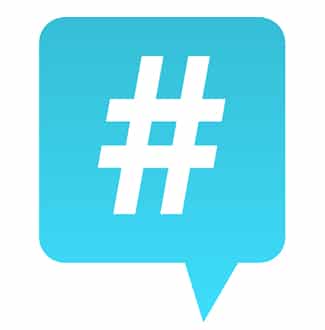
Hashtags are marketed and promoted actively across all platforms of media. No matter where you set eyes on, you will find a hashtag being used for one purpose or the other. Even on news channels, you will find hashtags being generated for every breaking news story around and those hashtags are used by viewers to put up their opinions on the matter. What this trend of using hashtags proves beyond doubt is that digital marketers cannot ignore them anymore.
What’s more, thanks to the popularity of the hashtags, they are not limited to Twitter alone. Almost all the social media channels, including Facebook and Instagram, are using hashtags. This makes the case stronger for internet marketers to leverage more value out of their hashtags. With the smart and judicious use of hashtags, they can organize social media chatter about their brand and even drum up more noise on those particular hashtags.
In this post, we will individually look at different social media platforms and how you can use hashtags in those channels.
What are hashtags & importance of hashtags
A hashtag is a type of metadata tag used on social networks such as Twitter, Facebook, YouTube, LinkedIn and other microblogging services. They allow users to applied labels to groups of messages, making it easier for others to find and follow conversations on specific topics. Hashtags are usually created by using the pound sign (#) followed by a word or phrase, with no spaces in between. For example, the hashtag #socialmedia would be used to label any conversation related to social media.
The importance of hashtags lies in their ability to help users easily find and follow conversations that are relevant to their interests. In a fast-paced and constantly-evolving environment like social media, hashtags provide a valuable way to keep track of trending topics and join in on the latest conversations. Hashtags can also be used to start new conversations, bringing together people with common interests from all over the world. Whether you’re looking to join an existing conversation or start a new one, hashtags are an essential tool for Navigation social media.
Right number of hashtags to use in social media marketing
Hashtags have become an essential part of social media marketing. They provide a way to track and measure the engagement of your posts, and they also help to increase the reach of your content. However, it’s important to use hashtags judiciously, as too many hashtags can actually have a negative effect on your marketing efforts.
The right number of hashtags to use depends on the platform you’re using and the goals of your campaign. For example, if you’re looking to boost brand awareness, using one or two hashtags on Twitter is usually sufficient. However, if you’re running a contest or promotion on Instagram, you may need to use several hashtags in order to reach a wider audience. Ultimately, the best way to determine the right number of hashtags to use is to experiment and see what works best for your business.
How to find relevant hashtags for your business
hashtags are one of the most powerful tools in a marketer’s toolkit. When used correctly, they can help you reach a wider audience, engage with potential customers, and build brand awareness. However, finding the right hashtags for your business can be a challenge. Here are a few tips to get started:
- Start with your customers. What hashtags do they use? What hashtags are relevant to your industry?
- Use hashtags that are specific to your business. Generic hashtags may be popular, but they won’t do much to help you reach your target audience.
- Use a mix of popular and niche hashtags. Popular hashtags will help you reach a larger audience, while niche hashtags will help you connect with potential customers who are specifically interested in your product or service.
- Use tools like hashtagsforlikes.com to find popular and trending hashtags in your industry.
- Experiment and track your results. Try out different hashtags and see which ones generate the most engagement. Then, adjust your strategy accordingly.
This microblogging site is the mother of the hashtag phenomenon. To help users tweeting on a single topic, hashtags were first used to bring them all under a single umbrella. This helped users in taking the discussion and chatter forward. These days, the popularity of hashtags has spilled it over to other social channels as well.
On Twitter, the hashtag can be as long and short as you want, provided your entire tweet stays within 140 characters. The key to use Twitter hashtags for branding is to ensure that you promote it actively and encourage followers to participate in discussions with these hashtags. If you feel that your hashtags are not grabbing enough eyeballs, you can try out event hashtags because they are always popular. Like #Christmas or #NewYear.
Definitely the most popular among the social networking channels, the use of hashtags on Facebook is a bit of a mixed bag. On the positive side is the fact that you can use as many hashtags for a particular post as you want. On the negative side, the technology on Facebook in utilizing hashtags is a confusing proposition.
For example, if you conduct a search based on a hashtag, you will end up with a Facebook page on that particular topic! It is must easier to use the hashtag in the form of a URL, like facebook.com/hashtag/corals to look for #corals. However, with the popularity of Instagram hashtags picking up a storm, Facebook is fine-tuning its own backyard.
The rule here is that you cannot use any special symbols in the hashtag except the underscore (_). You can, of course, use numbers here. In fact, while posting a single photo, you can use 30 hashtags at max! If you have already posted the photo, you can publish the hashtags in the Comments section.
The key to effectively use Instagram hashtags is to find out the trending ones and using them according to relevance. For brands looking at Instragram hashtags to reach out to newer audiences, take the path of hashtag games. They are always useful, just like using location-based hashtags. Location names can be in full, like #NewYork or an abbreviation like #NY.
Google Plus (Deprecated)
Another biggie in the pond, Google Plus does not allow for spaces in the hashtag, just like everyone else. You can use any kind of character, except that there will be no linking to the hashtag if you do not use only numbers, letters and the ubiquitous underscore. So, you are better off using these only!
There is a difference between how Google Plus looks at hashtags as opposed to the other social media channels on this list. It is not about assimilating all the hashtag posts in one banner alone. Google Plus tries to make way for more searches by users. In fact, research has shown that descriptive hashtags work better on Google Plus than event or even location-based ones.
The Final Word
As evident, each social media network comes with its own share of positives and requisites. The idea is to tune your hashtag accordingly. Since the hashtag is definitely here to stay, you will do well to embrace it in all its diverse avatars.







0 Comments